« March 2011 | Main | June 2011 »
May 25, 2011
About prescription dive masks
As scuba divers we need to be able to see and read our instruments at all times, so how do people who wear glasses cope? For a long time, glasses simply weren't an issue for me, but then came a day where, infuriatingly, I had to squint my eyes to read something small. I thought it was just an eye allergy, but no. For me it was welcome to the world of reading glasses. How does that affect diving?
Obviously you can't wear your regular glasses under a diving mask. One option is contact lenses, but they can get flushed out if you need to clear your mask or get splashed on. Not likely, but it can happen.
Another is getting a mask that can be fitted with optional optical lenses (most masks can be equipped with special lenses made with your prescription), or may even have separate optical windows downward. Many can easily be equipped with optical glass from -1.5 to -8.0 diopters in .5 increments.
Me, I found myself in the category of divers who have good vision but need reading glasses, so I looked into stick-on reading lenses. Stick-on lenses come in many magnifications, are re-usable, and leave no residue, so I tried them first. They usually look like soft plastic segments of a circle. You figure out where they should be in your mask, make sure the mask is totally clean, and then you apply the lens onto the wet mask and let it dry.
I did that before a dive trip to Florida a few years ago. On my first dive at Devil's Den I realized that I couldn't see a thing. I somehow had misinterpreted the instructions and the lenses totally obstructed my normal field of vision. That was so annoying that I took them out and made do without lenses for another two or three years. That's actually possible because water magnifies by about 33%. The magnification effect can be significant and you may find that you can read your instruments or dive computer while diving even if you can't on dry land!
But like most who need reading glasses, I found that I rapidly graduated through magnifications, and soon even the different optics underwater could no longer compensate. So I tried stick-on lenses again. First they just wouldn't stick. That can happen because for some hard-to-understand reason, many dive mask manufacturers insist on engraving their company or brand name at the bottom inside of the glass. Which means the lens is much less likely to stick. I asked around for a solution, and found a dive master who swore by glueing the lenses with something called liquid glass or such.
I bought a tube of it, followed instructions meticulously, but with awful results. The glue smeared, and while it was indeed clear, there was so much optical distortion as to render the inserts useless. Out they came, and I set the font size on my dive computer to maximum.
At DEMA 2008 I came across the folks at Prescription Dive Masks in La Mesa, California. They specialize on dive optics and nothing else, and they even have licensed opticians on staff. I saw them again at DEMA 2010 and decided to give them a shot. With just a week and a half to go before a big dive trip, we sent in our masks, having been assured they'd be back in time.
Not only were they back with time to spare, but the quality was just outstanding. Not only did we get much better optics and a larger viewing area than from generic stick-ons, but Prescription Dive Masks also custom-fitted them to our masks. See the difference between their solution (left) and generic stick-ons (right) in the picture below.

Getting optical inserts done professionally is more expensive than buying generics, but it's well worth it. Not being able to reliably see the data on your dive computer is foolish, as is missing that once-in-a-lifetime shot because you can't quite see the controls or settings on your camera.
So if you find yourself in a vision predicament with your mask, check what Prescription Dive Masks has to offer on their site. Or you can call and describe what you need at (619) 698-2878.
Posted by conradb212 at 8:53 PM
May 8, 2011
Visiting and diving the Georgia Aquarium
Encountering sharks in the wild is rarer than one might think. Many divers never see a shark, and for many others it is a once in a lifetime experience. But if spotting any shark underwater is an uncommon occurrence, the chance of encountering a whale shark is practically nil unless you go on special whale shark trips, and even then success isn't guaranteed.
There is, however, a way to not only see whale sharks, several of them, but also more sharks than most divers will ever see, all in one dive. That's when you dive the Georgia Aquarium in Atlanta. They have a 6.3 million gallon exhibit with thousands of fish, including tiger sharks, hammerheads, zebra sharks, rays, guitarfish, humpback wrasses and whole schools of tarpon, pompano and cownose rays. And whale sharks. Four of them.
I got to experience diving the Georgia Aquarium, the world's largest, on my birthday. For the occasion, Carol had organized a weeklong trip that took us first back east to see her parents, then on to Atlanta, Georgia, in a rental. I had no idea what was on the agenda but the destination became clear soon enough.

The exceedingly attractive Georgia Aquarium, which first opened in 2005, is organized as a collection of exhibits around a huge open center hall. There's the Georgia Explorer where you can see and touch rays and learn about underwater life in and off Georgia. Next to it is River Scout where you can see what's going on in rivers, from the bottom. 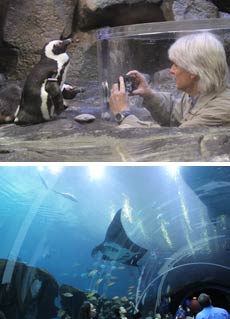 That includes piranhas who don't look nearly as intimidating as their reputation suggests. The wow! factor then ratchets up a few notches with the Cold Water Quest with a huge beluga whale tank, a hilarious penguin exhibit, spooky spider crabs and more. Tropical Diver is next (last, actually, if you go through the exhibits clockwise), and its centerpiece is a stunning reef with live coral. Seeing all this color and underwater life behind invisible viewing glass larger than most movie theater screens is a total mind blower.
That includes piranhas who don't look nearly as intimidating as their reputation suggests. The wow! factor then ratchets up a few notches with the Cold Water Quest with a huge beluga whale tank, a hilarious penguin exhibit, spooky spider crabs and more. Tropical Diver is next (last, actually, if you go through the exhibits clockwise), and its centerpiece is a stunning reef with live coral. Seeing all this color and underwater life behind invisible viewing glass larger than most movie theater screens is a total mind blower.
Then there's the big 6-million gallon Ocean Voyager tank, designed to illustrate life in the Mesoamerican barrier reef system. You experience this walking through a 100-foot glass underwater tunnel that offers probably among the most breathtaking sights ever. I mean, where else could you sit down and watch tens of thousands of fish parade by and over you? It's of course, the big game that makes your jaw drop and wonder if you're in some kind of vivid dream. Mantas flying by, hammerheads cruising, huge groupers, too many incredible creatures to count.
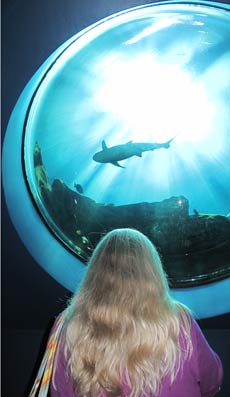 And then the whale sharks. Whale sharks are the largest fish on the planet. Though they are technically sharks, they are entirely docile and only eat (vacuum would be a better term) plankton. The Georgia Aquarium has four of them, purchased from Taiwan where they had been captured under a quota system (since closed, see here) and would have been killed and eaten had the aquarium not purchased them. Now there are, of course, some questions as to whether an aquarium, even one as large as Atlanta's, should have creatures as huge as whale sharks, and there was also a learning process both for the whale sharks (how to feed from buckets, etc.) and for the aquarium (the logistics of relocation, care and feeding are enormous), and two of the original four whale sharks expired early on. Their replacements, and the other two originals, seem to be doing fine.
And then the whale sharks. Whale sharks are the largest fish on the planet. Though they are technically sharks, they are entirely docile and only eat (vacuum would be a better term) plankton. The Georgia Aquarium has four of them, purchased from Taiwan where they had been captured under a quota system (since closed, see here) and would have been killed and eaten had the aquarium not purchased them. Now there are, of course, some questions as to whether an aquarium, even one as large as Atlanta's, should have creatures as huge as whale sharks, and there was also a learning process both for the whale sharks (how to feed from buckets, etc.) and for the aquarium (the logistics of relocation, care and feeding are enormous), and two of the original four whale sharks expired early on. Their replacements, and the other two originals, seem to be doing fine.
Watching those giants glide by is an unbelievable sight. I just stood there, mesmerized. Then Carol asks me how I'd like to dive with them. I said I'd probably be a bit intimidated. She smiles and pulls my scuba mask out of her purse! Talk about being at a loss for words.
So we did dive the Georgia Aquarium. It's a great experience. We had a small group of just four, us and another couple. We got an intro and look behind the scenes, then suited up in gear supplied by the aquarium (you can bring your own mask, but they'll first disinfect it for the safety of the fish). While from below, walking through the underwater tunnel, the tank looks like the bottom of the sea, from above it looks like nothing but a giant swimming pool. Above where the tunnel is, huge fans blow on the water so visitors cannot see through the surface.
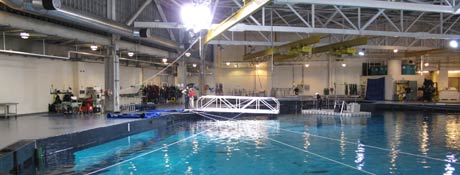
We sat down by the edge of the tank, with instructions to descend feet-first to the bottom, stay close to our dive buddy, and strictly follow the dive guide. Before we could even get in, Carol almost stepped on a whale shark who'd come to investigate. Then we both needed some extra weight. Finally we descended into the tank.
I had no idea what to expect. To most, descending into a tank filled with sharks doesn't exactly qualify as a desirable experience, but I actually wasn't afraid. I figured that since the aquarium does those tours, there was nothing to worry about. Once at the bottom and following the dive master, it became like being inside a particularly intense 3D IMAX movie. It was definitely information overload. Instead of looking out for wildlife, the sharks were everywhere. Hammerheads buzzed by, with one almost bopping into us by accident (or we into him). Ferocious looking sand tigers, the distinctive zebra shark, the exceedingly odd wobbegong, blacktips, giant groupers, sawfish, and a whole bunch of rays. Mantas are particularly majestic, gliding like space craft, looping in the water.
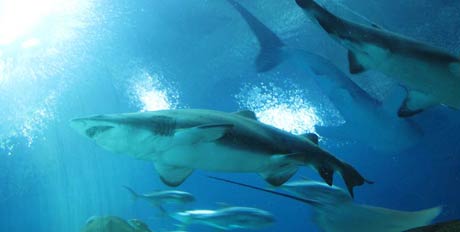
The underwater tunnel separates the tank into two halves and swimming over the tunnel was an experience in itself as visitors, and particularly kids, seemed as interested in us divers than in the fish. Little boys and girls were pointing, waving or, in one instance, running away in fear.
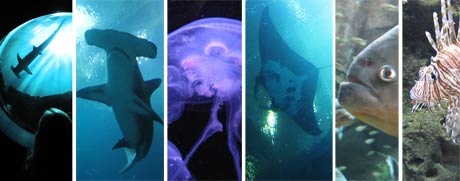
Then there were the whale sharks effortlessly cruising by and above us. As far as whalesharks go, the four in the Georgia Aquarium are not very large, perhaps 20 feet max (they can get to be 40 feet), but that's relative. Being in the water with not one, but four 20 foot sharks is an experience that almost defies explanation. It's awe-inspiring, majestic, unbelievable. And it was also over much too soon. The dive lasted 30 minutes or so, though with so much happening, there was no sense of time at all.

Diving the Georgia Aquarium isn't inexpensive (US$325 or so), but if you want to swim with whale sharks, mantas, and more other sharks than most divers will see in a lifetime, it's a total bargain.
Note that there are no cameras allowed, though a videographer accompanies every dive and the video of your dive will be ready after the debriefing.
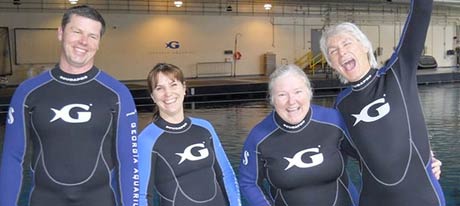
Posted by conradb212 at 3:58 PM








